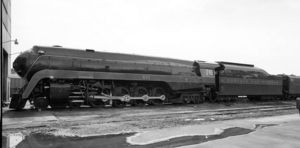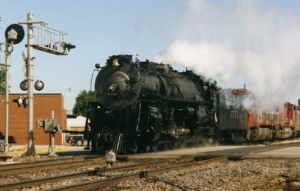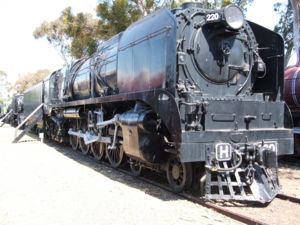4-8-4

Under the Whyte notation for the classification of steam locomotives, a 4-8-4 locomotive has four leading wheels arranged in a leading truck, eight coupled driving wheels and four trailing wheels in a trailing truck.
The equivalent UIC classification is 2'D2'.
The 4-8-4 was an obvious progression from the 4-8-2 "Mountain" and the 4-6-4 "Hudson" types, combining the 4-8-2's ability to have more weight on the driving wheels (leading to greater traction, and allowing a larger, more powerful locomotive) and the 4-6-4's larger firebox supported by a 4-wheel trailing truck, allowing for freer steaming, particularly at speed.
Contents
Development in the United States
The first 4-8-4 was produced in 1927 by Alco for the Northern Pacific Railway, and the type was therefore named "Northern". Southern railroads in particular obviously didn't find this name very suitable, so they chose other names for their 4-8-4 classes.
| Railroad | Name |
|---|---|
| Canadian National Railway | Confederation |
| Central of Georgia Railroad | Big Apple |
| Chesapeake and Ohio Railway | Greenbrier |
| Delaware, Lackawanna and Western Railroad | Pocono |
| Denver and Rio Grande Western Railroad | Western |
| Grand Trunk Western Railroad | Confederation |
| Lehigh Valley Railroad | Wyoming |
| Nashville, Chattanooga and St. Louis Railway | Dixie |
| Ferrocarriles Nacionales de Mexico | Niágara |
| New York Central Railroad | Niagara |
| Richmond, Fredericksburg and Potomac Railroad | General, Governor, Statesman (three different classes) |
| Southern Pacific Railroad | Golden State (or General Service) |
| Western Maryland Railway | Potomac |
The Northern type proved to be the best choice of locomotive arrangement for both express passenger and fast freight service. It wasn't suited to heavy drag freight, but faster and lighter trains were well suited to the type.
Given that the 4-8-4 was a late development and Northerns were often the 'name' passenger power at the time of steam's demise, many were saved from the scrapper's torch and are now preserved in museums, or in the case of a lucky few, kept in running condition.
The Union Pacific Railroad has a Northern on its roster that has never been retired from service, UP 844, the last steam locomotive built for the UP. It is used for charter service and for publicity for the railroad. It also holds the unique distinction of being the only steam locomotive never retired by a Class I railroad.
Other countries
France
The lone SNCF 242A1 prototype, rebuilt from an unsuccessful Etat three cylinder 4-8-2 simple expansion locomotive into a three cylinder 4-8-4 compound locomotive. This remarkable locomotive achieved both extraordinary power outputs and efficiencies in coal and water use,[1] but no further examples were built as the SNCF focussed on electric traction for its future motive power development. 242A1 was scrapped in 1960.
Germany
The Deutsche Reichsbahn in 1939 took two prototypes of the BR 06 into service. They were designed for heavy express trains with a speed up to 140 km/h (87 mph).[2] However due to World War II, no more units were produced and as trains in Germany are less heavy, no real need was seen for such a heavy express train locomotive. Many parts as the boiler were standardised and also used in BR 45 heavy freight train locomotives. Both BR 06 prototypes were scrapped in the 1950s.
Australia
Three classes of 4-8-4 tender locomotive have been built in Australia:
- The South Australian Railways 500 class of 1926, originally a 4-8-2 design, was modified in 1929 into the 4-8-4 500B class by the replacement of the trailing axle with a booster-equipped four wheel trailing truck.[3]
- The Victorian Railways H class three cylinder 4-8-4 of 1941, designed for heavy passenger work on the Melbourne-Adelaide line. It was the largest non-articulated locomotive ever built in Australia.[4] Due to necessary upgrades to the Adelaide line being deferred, the H class only ever operated on the Melbourne-Albury line, achieving success as a fast freight locomotive.
- The streamlined South Australian Railways 520 class of 1943, able to run on lightly-constructed 30kg/m (60 lb/yd) track by virtue of the engine unit's weight being spread over eight axles.[5] Their streamlining bears a strong resemblance to that of the PRR T1 locomotive.
New Zealand
The NZR K, Ka and Kb class locomotives were introduced from 1932 onwards to answer a requirement for a more powerful locomotive that could operate within New Zealand's tight loading gauge.[6]
South Africa
In 1953, a time when 4-8-4s on many American railroads were being replaced by diesel electric locomotives, South African Railways introduced the Class 25 4-8-4.[7] These powerful locomotives were effectively a continuation of American 4-8-4 locomotive design, albeit scaled down slightly for 3' 6" (1067 mm) narrow gauge operation.[8] A novel feature of many of the Class 25 locomotives was the use of enormous condensing tenders, designed to save water in arid areas by converting exhaust steam back to water.[9]
In 1981, a Class 25 locomotive was rebuilt into the experimental Class 26NC "Red Devil". This relatively compact locomotive (the engine unit weighed just 123 metric tons) was capable of extraordinary power (in excess of 4,000 drawbar horsepower) yet delivered exceptional economy in coal and water use.[8] However, like the French 242A1 4-8-4 built thirty five years earlier, the 26NC remained a one-off. The SAR had decided to modernise its fleet with diesel and electric traction rather than invest further development in steam traction.
Soviet Union
The 4-8-4 arrangement was represented in the Soviet Union by the P36 series locomotives. They were the only semi-streamlined steam locomotives ever built in Russia. 251 examples were produced from 1954 to 1956.
Preservation
Many 4-8-4 locomotives have been preserved in museums, and a few are kept in operational condition. Some of the more notable of this type are:


- Atchinson, Topeka & Santa Fe 3751 - Restored in 1991, owned by the San Bernardino Railroad Historical Society
- Chesapeake & Ohio 614 - Restored in 1980, and again in 1995, currently owned by Iron Horse Enterprise
- Ferrocarriles Nacionales de México 3028 - Retired in 1966, acquired by the Great North Eastern Railroad Foundation and displayed at the Altamont, New York, fairgrounds until 1983. Currently on lease to and being restored by the New Hope and Ivyland Railroad.
- Grand Trunk Western 6325 - Restored in 2001 by the Ohio Central Railroad
- Milwaukee Road 261 - Restored in 1993, owned by the National Railway Museum in Green Bay, WI. Leased by North Star Rail in St. Paul, MN.
- New Zealand Government Railways Ka 935 - This locomotive is currently operating on the Silver Stream Railway, near Wellington, New Zealand.
- Ka 945 is under overhaul at Steam Incorporated, Wellington
- Ka 942 is under overhaul at Mainline Steam Wellington
- K 900 is displayed static at MORST Auckland
- Kb 968 is under overhaul at Mainline Steam Christchurch
- K 911 - under overhaul at Mainline Steam, Wellington.
- K 917 - stored Steam Incorporated, Wellington
- Norfolk & Western 611 - Ran frequent excursions in the 1980s and early 1990s, currently on display in the Virginia Museum of Transportation.
- Reading 2100-Restored in 1988, and 1998, converted to burn oil in the Early 2000s. Now in Tacoma, WA for excursion service as of 2006.
- Reading 2124 Used on the "Reading Rambles" in the late 1950s and 1960s. On static display at Steamtown in Scranton, PA.
- St. Louis Southwestern 819 - Restored to service in 1988, currently stored in Pine Bluff, AK
- St. Louis-San Francisco Railway 4501 - Built in 1942, ran overnight passenger service between St. Louis, Tulsa, and Oklahoma City. Donated to the Dallas Museum of the American Railroad in September 1964
- Spokane, Portland and Seattle 700
- South Australian Railways 504 - Currently in static preservation at the National Railway Museum in Port Adelaide.
- South Australian Railways 520 - Restored to service in 1972, this streamlined locomotive currently operates on the Steamranger tourist railway between Mt Barker and Victor Harbor
- Southern Pacific 4449 - still in operation, served as the locomotive for the Bicentennial American Freedom Train
- Southern Pacific 4460 - on static display at the Museum of Transportation in St. Louis, Missouri. This was the last steam locomotive used in revenue service by the SP.
- Union Pacific 844 - the last steam locomotive built for Union Pacific Railroad; it has never left the UP roster, and is currently running in excursion service.
- P36 no.0032 - the only private steam locomotive operated in Russia. Owned by GW Travel.
References
- ↑ chapelon.net Technical Data Index - retrieved 1st November 2006
- ↑ dbtrains.com BR 06 - retrieved 1st November 2006
- ↑ National Railway Museum - 500B-class 4-8-4 steam locomotive No.504 "TOM BARR-SMITH" - retrieved 1st November 2006
- ↑ ARHS Railway Museum: What to see - H220 - retrieved 15th October 2006
- ↑ National Railway Museum - 520-class 4-8-4 steam locomotive No.523 "Essington Lewis" - retrieved 1st November 2006
- ↑ ipenz.org.nz Engineering Heritage - retrieved 1st November 2006
- ↑ SAR Class 25NC 4-8-4 - retrieved 3rd November 2006
- ↑ 8.0 8.1 The Ultimate Steam Page - David Wardale - retrieved 3rd November 2006
- ↑ SAR Class 25 4-8-4 - retrieved 3rd November 2006
- ↑ (based on SNCF 242A1 and DR BR 06 locomotives being scrapped) steamtrainartist.com Victorian Railways H Class 4-8-4 - retrieved 1st November 2006
See also
Steam locomotive types | |
|---|---|
| Single engine types | 0-2-2 • 2-2-0 • 2-2-2 • 2-2-4 • 4-2-0 • 4-2-2 • 4-2-4 • 6-2-0 0-4-0 • 0-4-2 • 0-4-4 • 2-4-0 • 2-4-2 • 2-4-4 • 4-4-0 • 4-4-2 • 4-4-4 0-6-0 • 0-6-2 • 0-6-4 • 2-6-0 • 2-6-2 • 2-6-4 • 2-6-6 • 4-6-0 • 4-6-2 • 4-6-4 0-8-0 • 0-8-2 • 0-8-4 • 2-8-0 • 2-8-2 • 2-8-4 • 2-8-6 • 4-8-0 • 4-8-2 • 4-8-4 • 4-8-6 • 6-8-6 0-10-0 • 0-10-2 • 2-10-0 • 2-10-2 • 2-10-4 • 4-10-0 • 4-10-2 0-12-0 • 2-12-0 • 2-12-2 • 2-12-4 • 4-12-2 • 4-14-4 |
| Duplex engine types | 4-4-4-4 • 6-4-4-6 • 4-4-6-4 • 4-6-4-4 |
| Garratt (articulated) types | 0-4-0+0-4-0 • 2-6-0+0-6-2 • 4-6-2+2-6-4 • 2-8-0+0-8-2 • 4-8-2+2-8-4 • 4-8-4+4-8-4 |
| Mallet (articulated) types | 0-4-4-0 • 0-4-4-2 • 2-4-4-2 0-6-6-0 • 2-6-6-0 • 2-6-6-2 • 2-6-6-4 • 2-6-6-6 • 2-6-8-0 • 4-6-6-2 • 4-6-6-4 0-8-8-0 • 2-8-8-0 • 2-8-8-2 • 2-8-8-4 • 4-8-8-2 • 4-8-8-4 2-10-10-2 • 2-8-8-8-2 • 2-8-8-8-4 |
